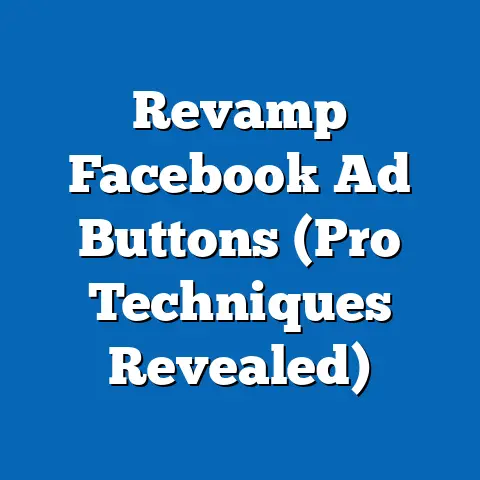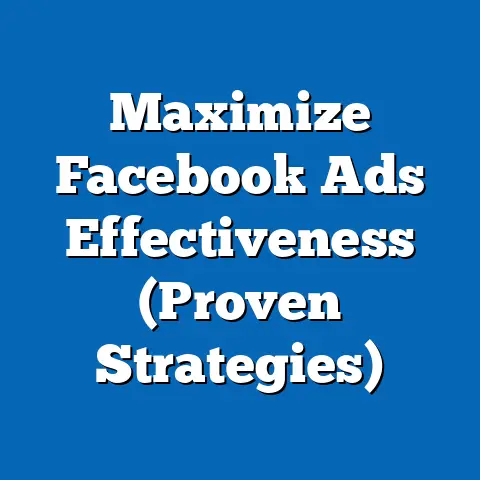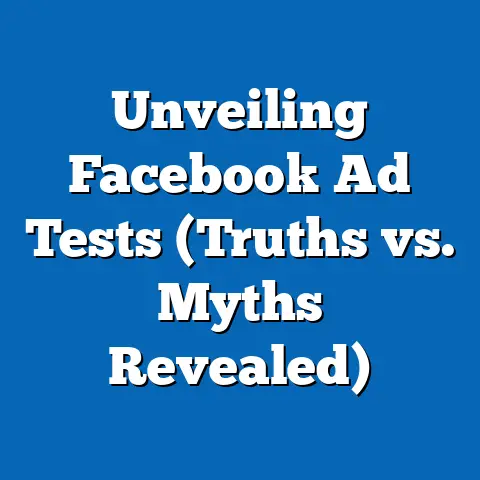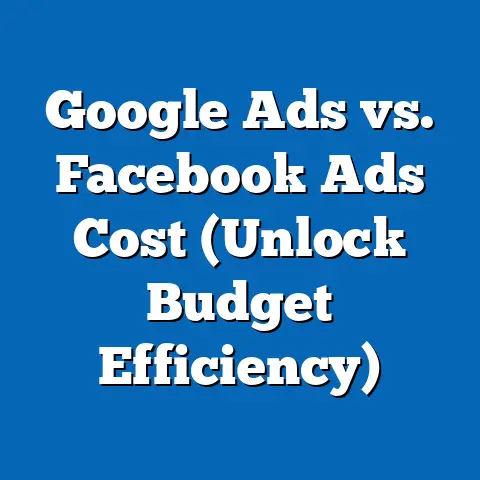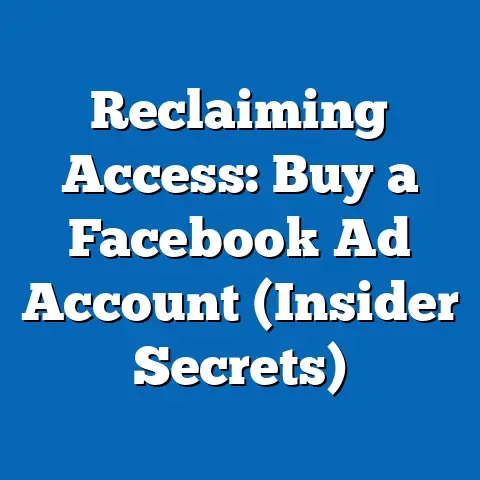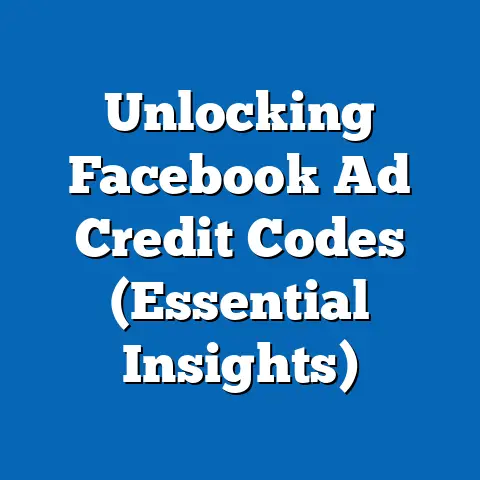Unlocking Bank Ads on Facebook (Expert Strategies Revealed)
I remember attending a digital marketing conference a few years ago and being absolutely floored by the statistics around Facebook ad spend. The sheer volume of money pouring into the platform was staggering. But what really caught my attention was the growing trend of banks shifting their advertising dollars from traditional channels to the digital realm, specifically Facebook. In fact, recent data shows that banks are allocating upwards of 40% of their marketing budgets to digital advertising, with a significant portion going directly to Facebook. This shift isn’t just a fad; it’s a strategic move driven by Facebook’s unparalleled reach and sophisticated targeting capabilities.
For banks, Facebook offers a golden opportunity to connect with potential customers, build brand awareness, and ultimately, drive conversions. But simply throwing money at Facebook ads isn’t a guaranteed path to success. It requires a deep understanding of the platform, a strategic approach to targeting, and a commitment to crafting compelling and compliant ad content.
The Current Landscape of Banking and Advertising
The world of banking has undergone a seismic shift in recent years, and the way banks market their services has had to evolve accordingly. Gone are the days of relying solely on newspaper ads, radio commercials, and billboards. Today, the battle for customers’ attention is fought in the digital arena, with social media platforms like Facebook taking center stage.
This evolution is driven by several factors. Firstly, consumers are increasingly spending their time online, particularly on social media. Secondly, traditional advertising methods are becoming less effective as consumers become more adept at tuning them out. Finally, digital marketing offers unparalleled opportunities for targeting, personalization, and measurement, allowing banks to reach the right customers with the right message at the right time.
Let’s look at some statistics. Facebook boasts over 2.9 billion monthly active users, making it the largest social media platform in the world. Within that massive user base, you’ll find a diverse range of demographics, interests, and behaviors, including a significant segment of potential banking customers. In fact, studies show that a large percentage of adults across various age groups actively use Facebook, making it a prime channel for banks to reach their target audience.
But the opportunity isn’t without its challenges. The banking sector is highly competitive, and banks are constantly vying for customers’ attention. To stand out from the crowd, banks need to leverage Facebook ads in a strategic and creative way, crafting compelling ad content that resonates with their target audience and differentiates them from the competition.
Key Takeaway: The banking industry is undergoing a digital transformation, and Facebook ads have become a crucial tool for reaching and engaging potential customers.
Understanding Facebook Ads for Financial Institutions
Before diving into the specifics of creating bank ads on Facebook, it’s important to understand the different types of ads available and how they can be used to achieve specific marketing goals. Facebook offers a variety of ad formats, each with its own unique strengths and weaknesses.
Here’s a rundown of some of the most popular ad formats for banks:
- Image Ads: These are simple yet effective ads that feature a single image and a short block of text. Image ads are ideal for building brand awareness, promoting specific products or services, or driving traffic to your website. I’ve seen image ads used effectively to showcase visually appealing images of new bank branches or highlight attractive interest rates on savings accounts.
- Video Ads: Video ads are more engaging than image ads and can be used to tell a story, demonstrate a product, or share customer testimonials. Banks can use video ads to educate potential customers about their services, build trust, and drive conversions. I once worked with a credit union that created a series of video ads featuring real customers sharing their positive experiences with the bank. The ads were incredibly successful in generating leads and driving new account openings.
- Carousel Ads: Carousel ads allow you to showcase multiple images or videos in a single ad unit. This format is ideal for highlighting a range of products or services, telling a story in a sequential manner, or showcasing different features of a single product. Banks can use carousel ads to promote different types of loans, highlight the benefits of their mobile banking app, or showcase customer success stories.
- Collection Ads: Collection ads are designed for e-commerce businesses and allow you to showcase a collection of products in a visually appealing format. While not directly applicable to traditional banking services, collection ads can be used to promote financial products that are sold online, such as insurance policies or investment products.
- Lead Ads: Lead ads are designed to generate leads directly within Facebook. When a user clicks on a lead ad, they’re presented with a form that’s pre-filled with their Facebook information. This makes it incredibly easy for users to submit their contact information, allowing banks to capture leads without requiring users to leave the Facebook platform. I’ve found lead ads to be particularly effective for promoting mortgage applications or credit card offers.
To create and manage your Facebook ad campaigns, you’ll need to use the Facebook Ads Manager. This powerful tool allows you to:
- Create and manage ad campaigns: You can set your campaign objectives, define your target audience, set your budget, and choose your ad placements.
- Create and design your ads: You can upload images and videos, write ad copy, and add call-to-action buttons.
- Track your campaign performance: You can monitor key metrics such as impressions, clicks, conversions, and cost per acquisition.
- Optimize your campaigns: You can make adjustments to your targeting, creative, and budget to improve your campaign performance.
Before you start creating your Facebook ads, it’s crucial to define your campaign objectives. What do you want to achieve with your ads? Are you trying to build brand awareness, generate leads, drive conversions, or something else? Once you know your objectives, you can tailor your ad content, targeting, and bidding strategies to achieve those goals.
Key Takeaway: Understanding the different types of Facebook ads and how to use the Facebook Ads Manager is essential for creating successful bank ad campaigns.
Targeting the Right Audience
One of the biggest advantages of Facebook advertising is its sophisticated targeting capabilities. Facebook allows you to target your ads to specific audiences based on a wide range of demographics, interests, behaviors, and connections. This means that you can reach the right customers with the right message at the right time, maximizing the effectiveness of your ad spend.
To effectively target your Facebook ads, you need to understand your target audience. Who are your ideal customers? What are their demographics, interests, and behaviors? What are their pain points and motivations?
Creating buyer personas is a great way to gain a deeper understanding of your target audience. A buyer persona is a fictional representation of your ideal customer, based on research and data about your existing customers. When creating buyer personas for your bank, consider the following factors:
- Demographics: Age, gender, location, income, education, occupation, and family status.
- Interests: Hobbies, interests, and activities.
- Behaviors: Online behavior, purchase history, and social media usage.
- Pain Points: Challenges and frustrations related to banking and financial services.
- Motivations: Goals and aspirations related to banking and financial services.
Once you have a clear understanding of your target audience, you can use Facebook’s targeting options to reach them with your ads. Facebook offers a variety of targeting options, including:
- Demographic Targeting: You can target your ads based on age, gender, location, income, education, and other demographic factors. This is useful for reaching specific segments of the population, such as young adults, homeowners, or retirees.
- Interest Targeting: You can target your ads based on users’ interests, hobbies, and activities. This is useful for reaching people who are interested in specific topics, such as personal finance, investing, or real estate.
- Behavior Targeting: You can target your ads based on users’ online behavior, purchase history, and social media usage. This is useful for reaching people who have recently purchased a home, applied for a loan, or visited your website.
- Custom Audiences: You can create custom audiences based on your existing customer data, such as email lists, phone numbers, or website visitors. This is useful for retargeting your existing customers or reaching new customers who are similar to your existing customers.
- Lookalike Audiences: You can create lookalike audiences based on your existing customer data. Facebook will find users who are similar to your existing customers based on their demographics, interests, and behaviors. This is useful for expanding your reach and finding new potential customers.
Retargeting is a particularly effective strategy for banks on Facebook. Retargeting allows you to reach users who have previously interacted with your bank’s website, app, or Facebook page. For example, you can retarget users who have visited your mortgage application page but haven’t completed the application. By showing them targeted ads, you can remind them of the benefits of your mortgage products and encourage them to complete the application.
Key Takeaway: Effective audience targeting is crucial for maximizing the ROI of your Facebook ad campaigns. By understanding your target audience and using Facebook’s targeting options, you can reach the right customers with the right message at the right time.
Crafting Compelling Ad Content
Even with the most precise targeting, your Facebook ads will fall flat if the content isn’t compelling. In the banking sector, where trust and credibility are paramount, crafting ad copy and visuals that resonate with your audience is crucial.
When writing ad copy for your bank’s Facebook ads, focus on clarity, trust, and compliance. Avoid using jargon or overly technical language that your target audience may not understand. Instead, use clear, concise language that explains the benefits of your products or services in a way that’s easy to understand.
Building trust is essential in the banking industry. Your ad copy should be honest, transparent, and accurate. Avoid making exaggerated claims or misleading statements. Instead, focus on building trust by highlighting your bank’s credentials, customer testimonials, and commitment to customer service.
Compliance is also a critical consideration for banks when advertising on Facebook. Your ad copy must comply with all applicable laws and regulations, including truth in advertising laws, privacy laws, and fair lending laws. Ensure that your ad copy is accurate, truthful, and does not discriminate against any protected groups.
Visuals play a crucial role in capturing attention and conveying your message on Facebook. Use high-quality images and videos that are visually appealing and relevant to your target audience. Consider using images of happy customers, attractive bank branches, or engaging animations to capture attention and convey your message.
A/B testing is a powerful technique for optimizing your ad creatives. A/B testing involves creating two or more versions of your ad and showing them to different segments of your target audience. By tracking the performance of each version, you can determine which one resonates best with your audience and use that version in your future campaigns.
For example, you can A/B test different headlines, images, or call-to-action buttons to see which ones generate the most clicks and conversions. I once ran an A/B test for a bank’s credit card ad campaign, testing two different headlines: “Get Rewarded with Our New Credit Card” and “Earn Cash Back on Every Purchase.” The “Earn Cash Back on Every Purchase” headline generated significantly more clicks and conversions, demonstrating the power of highlighting a specific benefit in your ad copy.
Key Takeaway: Compelling ad content is essential for capturing attention, building trust, and driving conversions. By focusing on clarity, trust, compliance, and visually appealing visuals, you can create Facebook ads that resonate with your target audience.
Navigating Compliance and Regulations
Advertising for financial institutions comes with a unique set of challenges, primarily due to the stringent regulatory environment. It’s not just about crafting a catchy slogan or a visually appealing ad; it’s about ensuring every aspect of your campaign complies with federal and state laws. Failing to do so can result in hefty fines, legal repercussions, and damage to your bank’s reputation.
One of the key regulatory considerations is truth in advertising. Your ads must be accurate, truthful, and not misleading. Avoid making exaggerated claims or false promises about your products or services. Be transparent about the terms and conditions of your offers, including interest rates, fees, and eligibility requirements.
Privacy laws are another important consideration. You must comply with all applicable privacy laws, including the California Consumer Privacy Act (CCPA) and the General Data Protection Regulation (GDPR). Be transparent about how you collect, use, and share customer data. Obtain consent from users before collecting their personal information and provide them with the opportunity to opt out of data collection.
Fair lending laws prohibit discrimination in lending based on race, color, religion, national origin, sex, marital status, or age. Your ads must not discriminate against any protected groups. Avoid using language or imagery that could be interpreted as discriminatory. Ensure that your ads are accessible to people with disabilities.
To ensure compliance, establish clear policies and procedures for creating and reviewing your Facebook ads. Train your marketing team on the applicable laws and regulations. Work with legal counsel to review your ad campaigns and ensure compliance. Use Facebook’s advertising policies to guide your ad creation process.
Transparency is key to building trust with potential customers. Be upfront about who you are and what you’re offering. Clearly identify your bank in your ads and provide contact information. Be transparent about your fees, interest rates, and other terms and conditions.
Ethical marketing is about doing what’s right, even when it’s not required by law. Be honest, transparent, and respectful in your advertising. Avoid using deceptive or manipulative tactics. Focus on building long-term relationships with your customers based on trust and integrity. I’ve always believed that ethical marketing isn’t just the right thing to do; it’s also the smart thing to do. Customers are more likely to do business with companies they trust, and they’re more likely to recommend those companies to their friends and family.
Key Takeaway: Navigating compliance and regulations is crucial for banks advertising on Facebook. By adhering to truth in advertising laws, privacy laws, and fair lending laws, you can avoid legal repercussions and build trust with potential customers.
Budgeting and Bidding Strategies
Determining your advertising budget is a critical step in creating a successful Facebook ad campaign. Your budget should be based on your overall marketing goals, your target audience, and your desired return on investment.
There are several ways to determine your advertising budget. One approach is to use a percentage of revenue. For example, you might allocate 5% of your annual revenue to advertising. Another approach is to use a cost-per-acquisition (CPA) target. For example, you might set a goal of acquiring new customers for $50 each.
Once you have determined your overall advertising budget, you need to allocate it across your different campaigns and ad sets. Consider the following factors when allocating your budget:
- Campaign Objectives: Allocate more budget to campaigns that are aligned with your most important business goals.
- Target Audience: Allocate more budget to ad sets that are targeting your most valuable customers.
- Ad Performance: Allocate more budget to ad sets that are performing well.
Facebook offers a variety of bidding strategies that you can use to optimize your ad spend. The right bidding strategy will depend on your campaign objectives and your target audience.
Here are some of the most common bidding strategies:
- Cost-Per-Click (CPC) Bidding: With CPC bidding, you pay each time someone clicks on your ad. This strategy is ideal for driving traffic to your website or landing page.
- Cost-Per-Impression (CPM) Bidding: With CPM bidding, you pay for every 1,000 impressions of your ad. This strategy is ideal for building brand awareness.
- Cost-Per-Action (CPA) Bidding: With CPA bidding, you pay each time someone takes a desired action, such as filling out a lead form or making a purchase. This strategy is ideal for driving conversions.
- Target Cost Bidding: With target cost bidding, you tell Facebook the average cost you’re willing to pay for a result, and Facebook tries to get you as many results as possible at or below that cost.
- Lowest Cost Bidding: With lowest cost bidding, Facebook tries to get you the most results possible for your budget, without regard to the cost per result.
Optimizing your ad spend is an ongoing process. You should continuously monitor your campaign performance and make adjustments to your budget and bidding strategies as needed. Consider the following tips for optimizing your ad spend:
- Monitor Your Key Metrics: Track your impressions, clicks, conversions, and cost per acquisition.
- A/B Test Your Ads: Experiment with different ad copy, images, and targeting options to see what works best.
- Adjust Your Bids: Increase your bids for ad sets that are performing well and decrease your bids for ad sets that are performing poorly.
- Pause Underperforming Ads: If an ad is not performing well, pause it and try a different approach.
- Use Budget Rules: Set up automated rules to automatically adjust your budget based on performance data.
Key Takeaway: Effective budgeting and bidding strategies are essential for maximizing the ROI of your Facebook ad campaigns. By determining your budget based on your goals and using the right bidding strategy, you can optimize your ad spend and achieve your desired results.
Measuring Success and Optimizing Campaigns
No marketing effort is complete without a robust system for measuring results and optimizing performance. With Facebook ads, this is particularly crucial, as the platform offers a wealth of data that can be used to fine-tune your campaigns for maximum impact.
Key performance indicators (KPIs) are metrics that you use to track the success of your ad campaigns. The KPIs that are most relevant to your bank will depend on your campaign objectives.
Here are some of the most important KPIs for banking ads on Facebook:
- Impressions: The number of times your ad is shown to users.
- Reach: The number of unique users who have seen your ad.
- Clicks: The number of times users have clicked on your ad.
- Click-Through Rate (CTR): The percentage of impressions that result in clicks.
- Conversions: The number of times users have taken a desired action, such as filling out a lead form or making a purchase.
- Conversion Rate: The percentage of clicks that result in conversions.
- Cost Per Click (CPC): The average cost you pay for each click on your ad.
- Cost Per Acquisition (CPA): The average cost you pay for each conversion.
- Return on Ad Spend (ROAS): The amount of revenue you generate for every dollar you spend on advertising.
Facebook Analytics is a powerful tool that you can use to track your campaign performance. Facebook Analytics allows you to:
- Track Your Key Metrics: Monitor your impressions, clicks, conversions, and other important metrics.
- Analyze Your Audience: Understand the demographics, interests, and behaviors of your target audience.
- Track User Behavior: See how users are interacting with your website or app.
- Create Custom Reports: Generate reports that are tailored to your specific needs.
- Integrate with Other Tools: Connect Facebook Analytics with other marketing tools, such as Google Analytics.
Ongoing optimization is essential for maximizing the ROI of your Facebook ad campaigns. You should continuously monitor your campaign performance and make adjustments to your targeting, creative, and budgets as needed.
Here are some tips for ongoing optimization:
- A/B Test Your Ads: Experiment with different ad copy, images, and targeting options to see what works best.
- Refine Your Targeting: Continuously refine your targeting based on performance data.
- Adjust Your Bids: Increase your bids for ad sets that are performing well and decrease your bids for ad sets that are performing poorly.
- Pause Underperforming Ads: If an ad is not performing well, pause it and try a different approach.
- Use Budget Rules: Set up automated rules to automatically adjust your budget based on performance data.
- Stay Up-to-Date: Keep up with the latest Facebook advertising features and best practices.
Key Takeaway: Measuring success and optimizing campaigns is crucial for maximizing the ROI of your Facebook ad campaigns. By tracking your KPIs, using Facebook Analytics, and continuously refining your campaigns, you can achieve your desired results.
Case Studies of Successful Bank Ad Campaigns
To illustrate the power of Facebook ads for banks, let’s take a look at some real-world examples of successful campaigns. These case studies highlight the strategies, challenges, and results achieved by banks that have effectively leveraged Facebook advertising.
Case Study 1: Regional Bank Boosts Mortgage Applications with Lead Ads
A regional bank wanted to increase the number of mortgage applications they received. They decided to run a Facebook lead ad campaign targeting homeowners in their service area. The ad featured a compelling image of a family in their new home and highlighted the bank’s competitive mortgage rates. When users clicked on the ad, they were presented with a pre-filled lead form that made it easy to submit their contact information.
- Strategy: Targeted homeowners with attractive mortgage rates using lead ads.
- Challenge: Ensuring compliance with fair lending laws.
- Results: Increased mortgage applications by 40% and reduced cost per acquisition by 25%.
Case Study 2: Credit Union Builds Brand Awareness with Video Ads
A credit union wanted to build brand awareness among young adults in their community. They created a series of video ads featuring real customers sharing their positive experiences with the credit union. The ads highlighted the credit union’s commitment to customer service and its focus on community involvement.
- Strategy: Used video ads to showcase customer testimonials and community involvement.
- Challenge: Capturing attention in a crowded social media feed.
- Results: Increased brand awareness by 30% and website traffic by 20%.
Case Study 3: National Bank Drives Credit Card Applications with Carousel Ads
A national bank wanted to drive applications for their new rewards credit card. They created a carousel ad showcasing the various benefits of the card, including cashback rewards, travel perks, and exclusive discounts. The ad targeted users who were interested in travel, dining, and shopping.
- Strategy: Highlighted credit card benefits with carousel ads targeting specific interests.
- Challenge: Differentiating their card from competitors in a saturated market.
- Results: Increased credit card applications by 35% and reduced cost per application by 15%.
These case studies demonstrate the versatility of Facebook ads and their ability to achieve a variety of marketing goals for banks. By understanding the strategies used by these successful banks, you can apply similar techniques to your own campaigns and achieve your desired results. I think the common thread in all these successful campaigns is a deep understanding of the target audience and a commitment to crafting compelling and relevant ad content.
Key Takeaway: Case studies provide valuable insights into the strategies, challenges, and results achieved by banks that have successfully utilized Facebook ads.
I’ve emphasized the importance of understanding your target audience, crafting compelling ad content, navigating compliance regulations, optimizing your budget, and measuring your results. By following these strategies, you can create Facebook ad campaigns that generate leads, drive conversions, and build brand awareness for your bank.
Facebook ads offer a powerful tool for banks looking to engage customers and drive conversions. With its unparalleled reach and sophisticated targeting capabilities, Facebook provides a unique opportunity to connect with potential customers and build lasting relationships.
I encourage you to evaluate your current advertising strategies and consider integrating Facebook ads into your marketing mix. By leveraging the power of Facebook advertising, you can enhance your visibility, reach a wider audience, and drive sustainable growth for your bank. So, take the plunge, experiment with different strategies, and unlock the full potential of Facebook ads for your banking institution!

